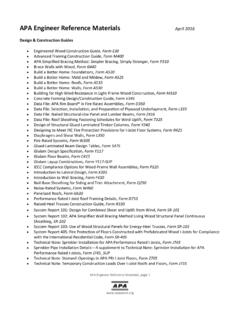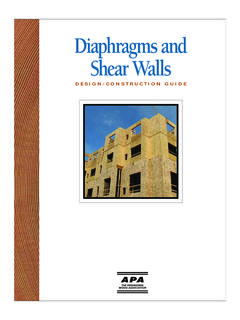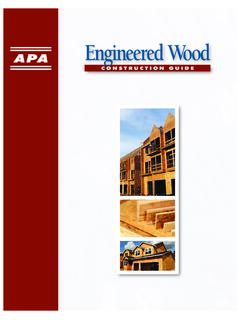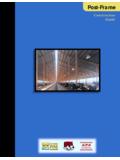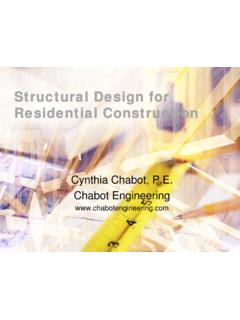Transcription of Engineered Wood Products FIRE DESIGN AND …
1 Engineered Wood ProductsEWP FDIG 01/21/2011 fire DESIGN AND installation GUIDE2 Boise Cascade EWP fire DESIGN and installation guide 01/21/2011 Boise Cascade EWP product ProfilesBCI Joists and VERSA-LAM Beams Western (White City, OR) BCI Joists and VERSA-LAM Beams Eastern (Lena, LA) ALLJOIST (St. Jacques, NB)BOISE GLULAM (Emmett, ID) product Profiles .. 2 Introduction, Residential construction and fire Safety ..3 - 5 Prevention .. 3 Detection .. 4 Containment, Evacuation .. 5 Engineered construction and fire Safety .. 6 Types of construction , fire Resistance Ratings .. 6 One Hour fire Resistance Rated Floor and Roof Assemblies .7 - 13 Two Layers " Type X Gypsum Wallboard - BCI and AJS Joists .. 7 Two Layers " Type C Gypsum Wallboard - BCI and AJS Joists .. 8 One Layer " Type C Gypsum Wallboard - BCI 60/90 and AJS Joists.
2 9 One Layer " Type C Gypsum Wallboard - BCI 60/90 and AJS Joists .. 10 One Layer " Type C Gypsum Wallboard & Strips - BCI 90 Joists and AJS 25/30 Joists .. 11 Three Layer " Type C Gypsum Wallboard - BCI and AJS Joists .. 12 One Layer " Type X Gypsum Wallboard VERSA-LAM ..13 Sprinkler Attachments ..14 Commercial Sprinkler Pipe Weights .. 14 Sprinkler Attachment Details FS01-FS21 ..14 - 17 BCI Joist Hole Location & Sizing .. 18 AJS Joist Hole Location & Sizing .. 19 Calculated fire Resistance .. 20 Calculated fire Resistance - VERSA-LAM ..20 Calculated fire Resistance - BOISE GLULAM ..21-22 Frequently Asked Questions Regarding fire Suppression ..23 Lifetime Guarantee .. Back CoverTable of Contents$-6 $-6 $-6 'HHS 'HSWKV $-6 $//-2,67 3 URGXFW 3 URILOHV )LUH 6 XSSUHVVLRQ $-6 %&, -RLVWV6 RPH SURGXFWV PD\ QRW EH DYDLODEOH LQ DOO PDUNHWV &RQWDFW \RXU %RLVH &DVFDGH (:3 UHSUHVHQWDWLYH IRU DYDLODELOLW\ %&, V %&, V %&, V %&, V %&, V 9(56$ /$0 WR WR 9(56$ /$0 WR (DVWHUQ 3 URGXFW 3 URILOHV%&, V 9(56$ /$0 WR 6 RPH SURGXFW V PD\ QRW EH DYDLODEOH LQ DOO PDUNHWV &RQWDFW \RX U %RLVH &DVFDGH (.)))))
3 3 UHSUH VH QW DWLYH IRU DYDLODELOLW\ %& , %& , %& , %& , %& , 9( 56$ /$ 0 WR 9( 56$ /$ 0 WR 9( 56$ /$ 0 WR 9( 56$ /$ 0 WR :HV WHU Q 3 URGXFW 3 URILOHV%& , -RLVWVH eader (Framing) BeamsArchitectural Appearance BeamsColumns$UFKLWHFWXUDO $SSHDUDQFH %HDPV,QGXVWULDO $SSHDUDQFH %HDPV&ROXPQV WR WR WR WR WR WR WR WR BCI 90e18"20"22"24"3 "1 "7/16"Boise Cascade EWP fire DESIGN and installation guide 01/21/20113 PreventionThe proper DESIGN , construction and maintenance of a building and its components are important steps in preventing a fire in the first place. The International Residential Code (IRC ) includes chapters on mechanical system requirements (chapter 13), fuel gas (chapter 24), and electrical (chapter 33) that require appliances and electrical components that have the potential to accidentally initiate ignition to be tested and listed for their respective application, and to bear a label from an approved listing agency with that construction and fire SafetyBoise Cascade manufactures and distributes quality Engineered Wood Products for modern construction throughout the United States and Canada.))))
4 These Products include BCI & AJS wood I-joists, VERSA-LAM beams/columns/studs, BOISE GLULAM beams/columns, and BOISE RIMBOARD Products . When compared to sawn lumber, Boise Cascade Engineered Wood Products provide higher strength, stiffness and dimensional consistency through more efficient use of raw materials to exacting industry quality standards required for modern manual provides detailed information for the DESIGN and construction professional about the relationship between Boise Cascade Engineered Wood Products , national building codes, and actual fire events. For further information, contact Boise Cascade EWP Engineering at (800) 232 -0788 or your local Boise Cascade performance of all structural building materials and systems degrade when exposed to fire and wood is no exception. Society s concern for fire safety is reflected in limitations and DESIGN requirements mandated through national building codes.
5 Significant improvement in material and building performance can be realized with knowledge of fire safety DESIGN and evaluation involving prevention, detection, containment, and evacuation. It is widely recognized that structure fires are highly variable in their size, rate of growth and intensity. Building contents (furniture, window coverings, electronic equipment, personal belongings) are the first items ignited and constitute the primary source of fuel in structure fires. Given all possible variations, there is no known way to determine how the fire will grow; therefore, each fire scenario is unique. If there is a fire in a structure, there is no safe amount of time that one can remain within the structure, even if everything was designed in accordance with all relevant codes and the time elapsed from ignition is Cascade EWP fire DESIGN and installation guide 01/21/2011 Attachment details for residential fire sprinkler systems are located on page 14 of this shown by the figure on fire Deaths per Million Population the , fire deaths have seen a 30% decrease from 1995 to 2007.
6 This reduction is primarily due to improved fire safety instituted through revisions to building codes and standards and occupant fire safety education. [Source: fire Administration, fire in the United States , 2003-2007, and 1995-2004, ]Residential construction and fire SafetySDKi tch enDiningLivi ng / Family Ba thro omMa st er Ba thro omHallwayBe dro omBe dro omMa st erBe dro fire Deaths / Million Population201816141210199520031997200519 99200720012009 Detection The IRC mandates the installation of smoke detectors in Chapter 3 Building Planning. The requirement for smoke detectors in all new home construction gives most occupants three to five minutes to escape from a home before smoke and flame become life threatening. Since the introduction of smoke detectors into homes, fire deaths have been reduced by nearly 50 percent. Per section of the IRC, smoke detectors are required in all bedrooms, outside bedrooms in the intermediate vicinity (hallway), and on each additional story, including R313 of 2009 IRC mandates fire sprinkler systems for all one and two family dwellings, effective January 1, 2011.
7 This new provision has received much debate within the residential construction and DESIGN community. At this time, several state and local jurisdictions have amended or revoked this provision. Please check with your local building official for further information regarding residential sprinkler requirements. Example of Residential Smoke Detector PlacementBoise Cascade EWP fire DESIGN and installation guide 01/21/20115 Residential construction and fire SafetyContainment The ability to contain the fire within a certain space is dependent upon the fire resistance of the walls, doors, ceiling, and floors. The IRC addresses containment in chapters 3 and 6, prescribing separation with provisions for exterior walls and attached garages. For residential basement ceilings, a simple, cost effective yet significant increase in fire resistance can be achieved by simply adding a single layer of " gypsum wallboard or " wood structural panel to the floor joists.
8 The use of such membrane protection will very likely more than double the fire -endurance time for all commonly used wood floor joist systems, including dimension lumber, open web trusses and I-joists. In addition, finishing the ceilings can increase the value of the home, increase floor performance, and reduce energy loss. It should be noted that this specific type of membrane protection will be mandated in the 2012 IRC for all joist types except dimension lumber, in structures that do not have automatic fire sprinkler systems. " Gypsum BoardEvacuationEmergency escape and rescue openings are addressed in chapter 3 of the IRC. Since the majority of residential fire deaths are the result of occupants sleeping during a fire , the IRC requires that all bedrooms and basements have adequate windows or doors for emergency escape purposes. KitchenDiningLiving / FamilyBathroomMaster BathroomHallwayBedroomBedroomMasterBedro omWindowDoorWindowWindowDoorSlidingDoorW indowWindowExample of Residential Evacuation Plan6 Boise Cascade EWP fire DESIGN and installation guide 01/21/2011 Engineered construction and fire SafetyEngineered construction refers to all buildings outside the scope of the IRC.
9 Building codes that address Engineered con-struction include the International Building Code (IBC ), the International fire Code (IRC ), the International Mechanical Code (IMC ), the International Fuel Gas Code (IFGC ), and the International Electrical Code (IEC ). These national codes address the fire safety DESIGN issues mentioned previously, only in greater Resistance RatingsFire resistance is the ability of materials or assemblies to prevent or restrict the passage of excessive heat, hot gases, or flames while continuing to support the structural loads. The performance of wall and floor assemblies exposed to fire is determined through testing in accordance with ASTM E 119 or NFPA 251 or CAN/ULC-S101. In a full-scale assembly test (at least 180 ft2 for a floor assembly and 100 ft2 for a wall assembly), a specimen is loaded to the maximum DESIGN load and directly exposed to flame.
10 The rate of temperature rise is controlled to follow a standard time-temperature curve. Results of full-scale fire endurance assembly tests provide a repeatable, relative measure of fire resistance based on three failure criteria: structural collapse, flame penetration, or excessive Types of ConstructionConstruction type is a function of occupancy classification (group), number of stories and feet above grade plane, and area per story. Type I & II The building elements are of noncombustible materials. VERSA-LAM and BOISE GLULAM are allowed in Type I & II roof construction where a 1-hour fire resistance rating is III The exterior walls are of noncombustible materials or fire retardant treated wood and the interior building elements are of any material permitted by code. VERSA-LAM , BCI Joists, AJS Joists, and BOISE GLULAM are allowed in Type III construction everywhere except for exterior load bearing walls.

